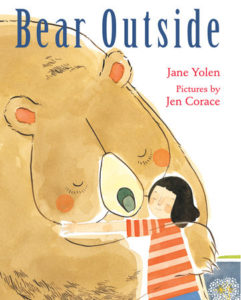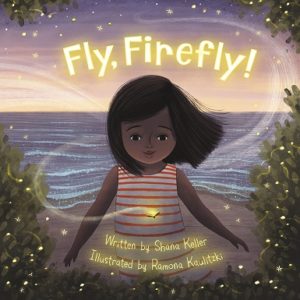For the first time ever, the review of the story-side of a picture book isn’t being done by Ryan G. Van Cleave (owner/operator of Only Picture Books).
Don’t worry, though. We’ve brought in ringers to handle things at the same high level we all expect of OPB picture book reviews.
So, without further ado, here’s this month’s picture book review that features insight from Brooklyn-based editor Octavia Saenz and Florida-based freelance artist (& OPB superfriend) Austin McKinley.
—Octavia’s Review of the Writing—
Bears are quiet, solitary things, but sometimes, if you look closely enough, you might find profound wisdom. Like the narrator of Bear Outside, the book itself is a quietly wise thing with a simple exterior that hides a deeper truth about what we owe ourselves.
The story is simple—and, like any good picture book, is half told in the details of the art—as the narrator explains how she wears her bear on the outside, as a form of protection, as a companion, as a talisman of courage. Beyond the narrator’s simple words, we see how the bear is a shield against mocking classmates as well as a a collaborator for the narrator having fun on their own. She says, too, that the bear is hers to take care of, and in the artwork we see her taking care of herself. She engages in brave and kind acts, fighting back bees to eat honey, and giving flowers to a neighbor, all with the help of the bear.
Bear Outside, celebrated author Jane Yolen’s 400th book, is an ode to kids who march to their own bear, and a guide for the imaginative ones in touch with their needs and boundaries.
It’s wonderful.
5 out of 5 pencils
—Austin’s Review of the Illustrations—
The central conceit of Bear Outside—that of a child imagining wearing their inner spirit as a kind of protective and companionable aura—is delightfully rich visual territory which the book’s artist, Jen Corace, explores with palpable joy. The sumptuous textural watercolor world she creates, which ranges from soft pastels to vibrant jewel-toned hues (the red leaves on that giant, two-page tree spread are chef’s kiss material!) is punctuated by Bear, the only cartoon element in each illustration described with a calligraphic line. As the book jacket explains, it was this conceptual image Corace created—of a girl surrounded by a bear—that formed the impetus for the book proper.
Corace has so much fun depicting Bear reading a book in a blanket fort (more great textures!) riding a bicycle, and jumping on a trampoline, that one can’t help but grin in appreciation. Her character and stage design have that quality of all the best children’s book illustrations: they are warm, inviting, approachable, and deceptively simple. Almost as if a child had done them, but a child with a master’s hand. It reminds us of the way we felt as children, and it makes it look easy.
Little touches–like the girl and Bear riding on the front of the shopping cart, clambering into a tree fort, flailing in water wings, or going to sleep with a night light–are all rendered in flattened perspectives. Overlapping watercolor elements and simplified backgrounds bring the childhood of our mind’s eye into a soft, sensitive focus.
A stroll through the artist’s website reveals there are many things about the imagery for this book that are motifs throughout her work. The little girl with the black bob haircut, the semi-translucent textures, and the fanciful combinations of people and animals all make regular appearances. Corace’s work here is moodier than her children’s illustration, more akin to what might appear on an indie record’s album art.
What makes Bear Outside unique is not just the more whimsical palette–it’s how charmingly relatable the scenes are, and the humor that arises when the core personality of the narrator and the alter ego of Bear seem to vie for dominance. It makes you want to have such a bear in your life, and the beauty of the book’s message is that you can!
It’s a powerful, inspiring piece of children’s literature, simple to understand, but taking a complex topic like healthy self-confidence, and making it impossible to forget.
5 out of 5 crayons
 Octavia Saenz is an editor and cartoonist based in Brooklyn, NY who creates visual narratives about queer, Puerto Rican diaspora. Octavia grew up in Puerto Rico and has a BFA in Creative Writing and Illustration from Ringling College of Art and Design, as well as a Lambda Fellowship.
Octavia Saenz is an editor and cartoonist based in Brooklyn, NY who creates visual narratives about queer, Puerto Rican diaspora. Octavia grew up in Puerto Rico and has a BFA in Creative Writing and Illustration from Ringling College of Art and Design, as well as a Lambda Fellowship.
Find her on Twitter and Instagram: @shrimpwonder.





